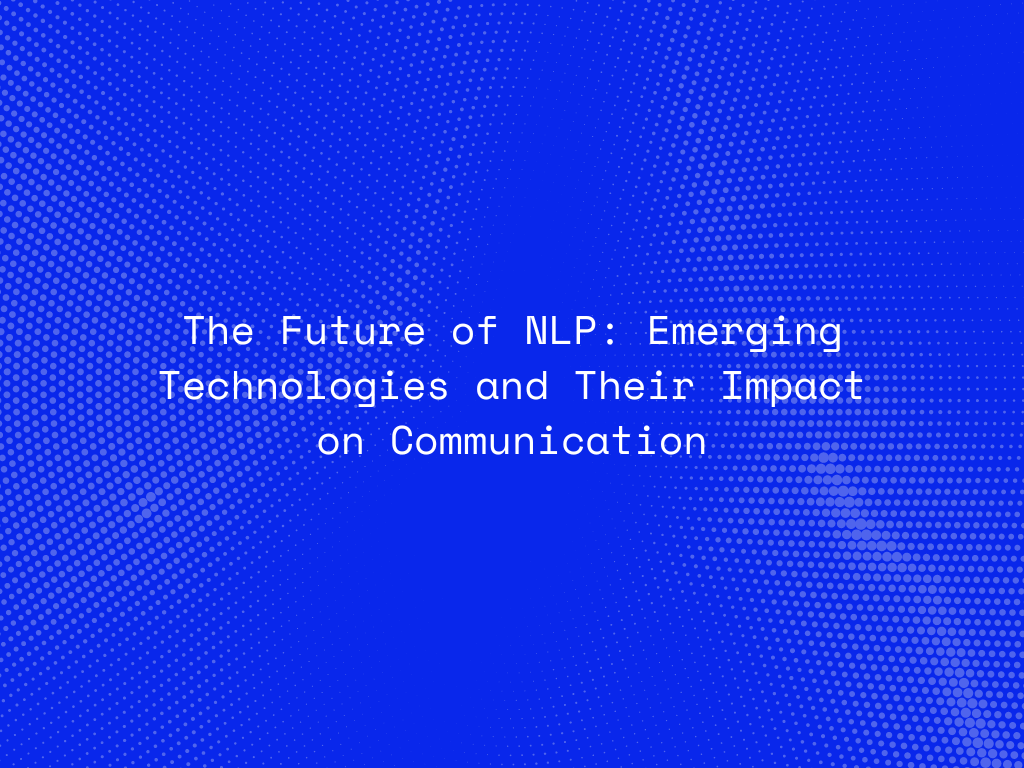Natural Language Processing (NLP) is one of the most transformative branches of artificial intelligence, enabling machines to understand, interpret, and generate human language. Over the past few years, NLP has evolved rapidly, giving rise to applications such as virtual assistants, real-time translation tools, and automated customer service systems. As we look to the future, emerging technologies in NLP are poised to revolutionize how we communicate and interact with machines. In this blog, we’ll explore the latest advancements in NLP and their potential impact on communication.
1. Transformers and Large Language Models
a) The Rise of Transformer Models
The introduction of transformer-based models, like GPT, BERT, and T5, has dramatically improved the capabilities of NLP systems. These models excel at understanding context, enabling more accurate language understanding and generation.
-
Contextual Understanding: Unlike earlier NLP models, transformers use self-attention mechanisms to grasp the nuances of context in sentences, leading to better comprehension of language and more natural conversations.
-
Applications in Translation and Summarization: Transformers have improved the accuracy of machine translation and text summarization tools, making communication across languages faster and more efficient.
b) Advances in Large Language Models (LLMs)
The development of LLMs like GPT-4 has pushed the boundaries of NLP. These models are pre-trained on vast datasets and fine-tuned for specific tasks, making them capable of generating coherent and contextually relevant responses.
-
Chatbots and Virtual Assistants: With LLMs, virtual assistants such as Siri, Alexa, and Google Assistant can engage in more natural and meaningful conversations, understanding complex queries and providing detailed responses.
-
Content Creation and Personalization: LLMs are being used to generate personalized content, from writing articles and generating code to creating product descriptions tailored to individual users.
Connect With Us
2. Conversational AI and Enhanced Human-Machine Interaction
a) Human-like Conversational Agents
The next generation of NLP-powered conversational agents is becoming increasingly human-like. Advances in emotion detection, intent understanding, and contextual memory are making these systems more responsive and capable of engaging in nuanced dialogue.
-
Emotional Intelligence: Emerging conversational AI systems can detect emotions in speech or text, allowing them to respond with empathy and adapt their tone to suit the context. This has applications in mental health, customer service, and education.
-
Context Awareness and Memory: NLP systems are gaining the ability to retain information across conversations. This allows them to provide more coherent interactions, remembering past exchanges and referring back to them as needed.
b) Multimodal Interaction
The future of NLP is not limited to text and speech but also includes multimodal systems that combine various forms of communication, such as images, video, and gestures.
- Voice, Text, and Visual Input: NLP systems are evolving to integrate visual information with language understanding, making communication more intuitive. For example, users can describe an image in words, and the system can interpret and respond to both the text and visual elements.
3. Real-Time Language Translation and Cross-Language Communication
a) Universal Translators
NLP is making strides toward achieving real-time, universal translation. With models that can understand and translate multiple languages simultaneously, cross-language communication is becoming more seamless.
- Real-Time Multilingual Conversations: Applications like Google Translate are leveraging NLP advancements to facilitate real-time conversations between speakers of different languages, breaking down communication barriers in business, travel, and international collaboration.
b) Low-Resource Language Support
One challenge in NLP is the availability of data for languages spoken by fewer people. Emerging technologies aim to overcome this by improving language models’ ability to understand and generate text in low-resource languages.
- Preserving Cultural Heritage: By supporting a wider range of languages, NLP can help preserve endangered languages and ensure that speakers of less common languages have access to global information.
Connect With Us
4. Natural Language Understanding (NLU) and Knowledge Extraction
a) Deep Language Comprehension
NLU technologies are improving machines’ ability to comprehend language at a deeper level. Future advancements will enable AI to better understand intent, meaning, and the subtleties of human communication.
- Sentiment and Intent Analysis: NLP systems will continue to improve in detecting the sentiment behind statements and accurately gauging user intent, enabling more sophisticated responses in customer service, social media monitoring, and marketing.
b) Automated Knowledge Extraction
NLP will play a key role in extracting valuable information from vast amounts of unstructured data, such as medical records, research papers, or legal documents.
- Healthcare and Legal Applications: In healthcare, NLP can help doctors by summarizing patient records or extracting relevant research from medical literature. In legal fields, it can streamline document review, improving productivity and accuracy.
5. Ethical Challenges and Responsible AI in NLP
a) Bias in Language Models
As NLP models become more widespread, the ethical concerns surrounding them also grow. One key issue is bias in the training data, which can result in discriminatory or harmful outputs.
-
Mitigating Bias: Future developments in NLP will need to focus on building models that are fair and unbiased, ensuring that they do not perpetuate stereotypes or amplify societal inequalities.
-
Transparency and Accountability: It’s essential for NLP systems to be transparent in how they generate outputs, particularly when used in critical areas like law enforcement, healthcare, and hiring.
b) Data Privacy and Security
With the increasing use of NLP in personal assistants and chatbots, there is a growing need to address data privacy and security concerns.
- Privacy-Preserving NLP: Future NLP systems will need to adopt more advanced encryption and anonymization techniques to protect users’ data while still providing high-quality services.
Connect With Us
6. The Impact on Communication and Business
a) Revolutionizing Customer Interaction
Businesses are already leveraging NLP for chatbots, virtual assistants, and automated support systems. In the future, we will see more sophisticated interactions that can handle complex customer requests, engage in personalized marketing, and provide faster, more effective support.
-
Conversational Commerce: NLP-driven systems will enable businesses to engage customers more interactively, with conversational AI handling everything from answering product questions to closing sales.
-
Customer Insights: NLP will continue to help companies mine customer conversations for valuable insights, predicting trends and improving customer experiences.
b) Content Creation and Curation
NLP is poised to transform how content is created and curated. AI-powered writing assistants, content generators, and summarization tools will enhance human creativity and improve information dissemination.
-
Content Automation: From news reports to social media posts, NLP will enable automated content creation, allowing businesses and media organizations to scale their content strategies.
-
Dynamic Personalization: Using NLP, marketers will be able to generate personalized content in real-time based on user interactions, improving engagement and driving conversions.
Conclusion
The future of NLP is filled with promise, as emerging technologies continue to push the boundaries of how machines understand and interact with human language. From real-time translation and personalized virtual assistants to more empathetic and context-aware conversational agents, the next wave of NLP advancements will reshape communication across industries. However, as we move forward, it is crucial to address the ethical and privacy concerns that accompany this technology, ensuring that NLP remains a force for good in improving human interaction.




